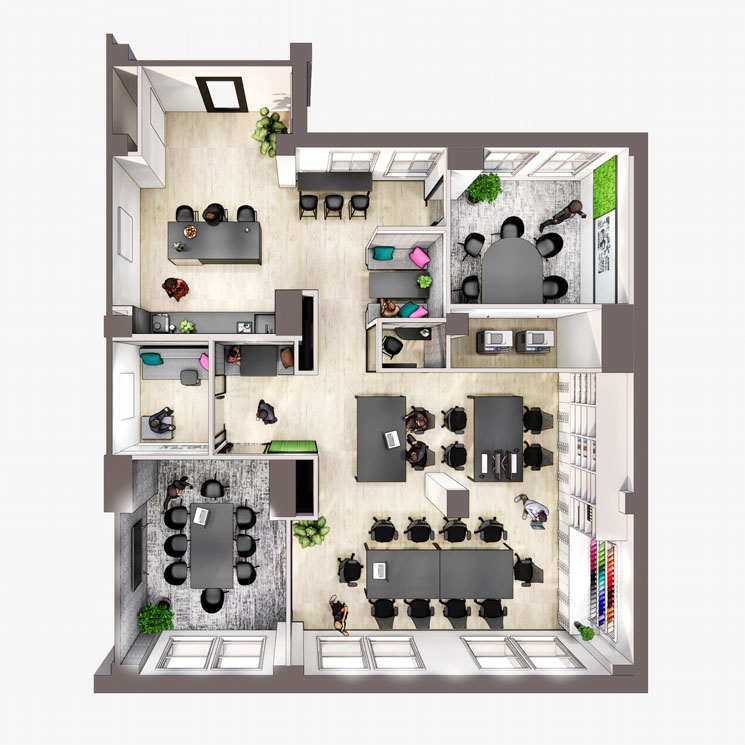The pandemic has prompted many questions about the future of the office. Is it dead? Is remote work here to stay? Will we go back to our old ways as soon as a vaccine arrives? Such questions have ignited a fierce debate among experts and society at large. The news cycle is dominated with stories of companies shedding space or shifting to remote work as a permanent option.
To those who ask me about the traditional office being dead, my response is clear and unequivocal: Yes, the office as we know it is dead, but that doesn’t mean it won’t be reborn in a new and better way. It is, in a way, experiencing a renaissance.
Change can be daunting, and for many, the option to just “wait it out” is an attractive one, but there’s one thing we know for sure: The scale, severity and duration of the pandemic has formed new working habits, set new expectations, and cemented strong beliefs among employees that will forever alter the purpose of the physical office.
For many companies, instead of a place where employees come to perform individual and task-oriented work for over eight hours a day, the office shifts to a resilient and adaptable space. A place where employees come as needed to touch down, interact, collaborate and ideate before transitioning back to remote work and individual tasks. This blended workplace also requires a digital work environment that integrates team culture and connects people both in and outside the physical workspace. In contrast to one centralized location, a blended workplace operates as an ecosystem of remote and communal settings, all connected digitally.
The office as we knew it is a thing of the past. Here’s why.
The need for human connection
At its core, the office serves one irreplaceable function – connecting people. While some of that is purely social, the physical workspace also drives innovation by enabling collaboration and the spontaneous cross-pollination of ideas. Experience has shown that bouncing ideas around, riffing off one another, exploring possibilities and developing plans is substantially limited in digital settings. Discussions are often hindered by challenges in bringing energy to a group setting, reducing conversations to the tactical level, falling short of the visionary and conceptual.
The physical workplace also plays a critical role in nurturing brand, culture and a collective sense of purpose among employees. Creating a feeling of inclusiveness, sharing vision and direction, mentoring, and making meaningful connections all contribute to an employee’s sense of belonging and safety, which contributes to a company’s success. And they all happen more organically when face-to-face. With coming to the office now a conscious choice instead of a default mode, we don’t come together just because we have to, we come together intentionally and for a purpose. We might even be more focused and productive when we do.

Rethinking the office footprint
There is no doubt that many companies are rethinking the size of their real estate footprint. But without strategically thinking about the right composition and focusing largely on reduction, organizations risk missing the opportunity to elevate their spaces to meet employee needs and enhance their performance.
With a new focus on human interaction, companies should consider repurposing space from individual assigned workstations to environments that accommodate a variety of needs. From appropriately spaced group settings to shared heads-down focus space for those who need, office design in our new normal cannot be rigid. It must provide built in flexibility and modularity to support and encourage a business and its employees to tailor the space to meet the needs of the day.
For some companies, this re-composition of office space introduces possibilities for a reduced footprint, while for others it allows a reallocation of a portion of the office portfolio. As an example, at our Vancouver office, we were able to support a distributed workforce through a smaller space composed to support the full team headcount and all their workplace needs. Flexible schedules, new workflows and seamless technology empower a smooth transition between in-office and remote work. Space reservation technology along with versatile and multi-purpose work settings, allow the team to book and reconfigure the space as needed to support their workflow.
Organizations looking to fully harness the potential of the post-COVID work environment must shift to behaviour-based design principles. This process begins by understanding people, defining personas, and outlining the behaviors that contribute to their best work. The results will guide the various space types required and provide a path to a long-term solutions, as opposed to blindly downsizing the office space to save money.
Transforming how we measure performance and impact
Changing the space alone is not enough. Hand-in-hand with the re-composition of space is a necessary transformation in how we assess work and performance. For example, performance measures must shift to focus more on “outputs” rather than traditional “inputs” such as attendance, hours spent working, presence in meetings, etc. This readjustment places the value on what we achieve more than the process of getting there. Working independently and autonomously will also become the norm as leaders empower their teams to make decisions and perform tasks with less direct oversight. Adaptive and collaborative work requires the right environments matched with the right workflows and technologies.
We must break old norms and push through to new ecosystems that build resiliency, foster human connections and nurture culture, purpose, and innovation. The blended workplace provides a vehicle for companies and their employees to embrace new ways of working and the renaissance the office needs to take on this new world.
Nabil Sabet is group director at M Moser Associates in Vancouver.






